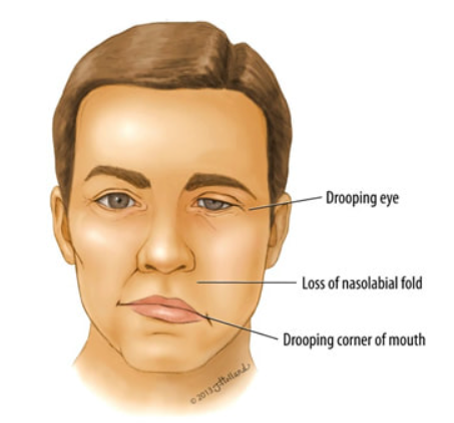ACTIVITY 4
This is patient AM, 28-year-old male who came in the ER because of drooping of his left face. He said he woke up and he could not move his left face.
He has no other muscle weakness. He is conscious and coherent although he had a little difficulty speaking because the left side of his lips drooped. He had normal blood pressure and he had no other co-morbidities. He was diagnosed to have Bell’s palsy. Name 5 muscles which are affected and list its actions. Describe the mechanism of his muscle weakness. What other symptoms could the patient exhibit as a result of facial muscle weakness?

FIVE MUSCLES AFFECTED BY BELL’S PALSY AND ITS ACTIONS
-
Occipitofrontalis (Frontal Belly) - Draws scalp anteriorly, raises eyebrows, and wrinkles skin of forehead horizontally as in look of surprise.
-
Orbicularis oculi - closes the eyes
-
Orbicularis oris - Closes and protrudes lips, as in kissing; compresses lips against teeth; and shapes lips during speech.
-
Buccinator - Presses cheeks against teeth and lips, as in whistling, blowing, and sucking; draws corner of mouth laterally; and assists in mastication (chewing) by keeping food between the teeth (and not between teeth and cheeks).
-
Platysma - Draws outer part of lower lip inferiorly and posteriorly as in pouting; depresses mandible.
MECHANISM OF BELL’S PALSY
Bell's palsy, sometimes referred as idiopathic facial palsy, is a form of temporary facial paralysis or weakening on one side of the face. It is caused from a dysfunction with cranial nerve VII, often known as the facial nerve, which controls the muscles on one side of the face and is responsible for movements like smiling and blinking. In some cases, it might have an impact on both sides of the face. Within 48 to 72 hours, symptoms will arise rapidly. After a few weeks, they will typically start to get better with or without treatment, and within six months, part or all facial function will return. Remaining muscular weakness can occasionally endure a long time or even be permanent.
OTHER SYMPTOMS OF BELL’S PALSY
Bell's palsy symptoms might differ from person to person and can range in severity from mild weakness to total paralysis. Other symptoms could include drooling, excessive tears in one eye, loss of nasolabial fold, difficulty closing one eye, drooping of the mouth, and unable to close one eye (causing dryness of the eye). Additionally, people may experience taste changes, facial pain or abnormal sensations, and a sensitivity to loud noises. These symptoms frequently result in considerable facial deformation.
References:
National Organization for Rare Disorders. (2018, June). Bell’s Palsy Fact Sheet. National Institute of Neurological Disorders and Stroke. Retrieved September 23, 2022, from https://www.ninds.nih.gov/bells-palsy-fact-sheet
Microbiology Nuts & Bolts. (2018, May 30). Ringing the infection “Bell” about facial nerve palsy. Microbiology Nuts and Bolts UK. http://www.microbiologynutsandbolts.co.uk/the-bug-blog/ringing-the-infection-bell-about-facial-nerve-palsy
Tortora, G. & Derrickson, B. (2014). Principles of Anatomy and Physiology (14th ed.). New Jersey, NJ: Wiley